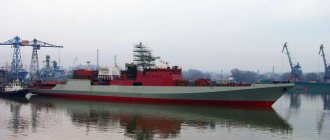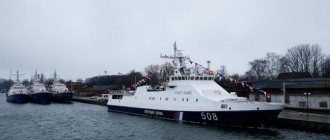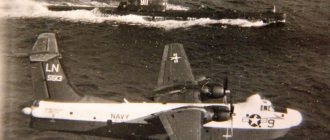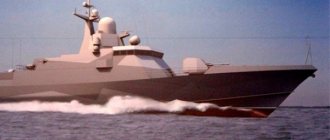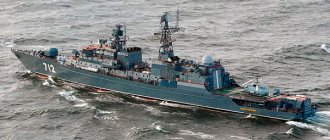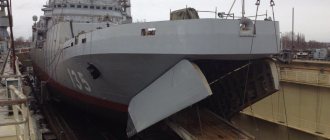Series of raid minesweepers "Sapphire" of project 10750
RT "Sapphire" becomes the next stage in the development of Project 1258, with the installation of a third propulsion engine, new weapons and structures made from improved materials. The design of the road minesweeper was redesigned in the second half of the 1980s. The main developer is PKB Almaz. Work manager – GK V. Blinov. The main purpose of the Sapphire RT is mine protection, search, trawling and destruction of mines in coastal areas, in areas of naval bases, dispersed at depths of no more than 80 meters.
Design and design of RT "Sapphire"
In the manufacture of the ship's hull, new solutions made of fiberglass were used, which ultimately led to a reduction in displacement and magnetic field (relevant for one's own protection when working with hydrodynamic mines at shallow depths). Solutions were also applied that reduced the intensity of the physical field of the new ship, low-magnetic steel of the SW type was used to create the load-bearing parts of the hull and mechanisms, and the power lines were made in special insulation. Hatches, doors, fences, ladders and fenders were made of aluminum and magnesium alloys.
The upper deck of the Sapphire RT was made straight with a sheer bow hull with a bulwark almost to the superstructure. The superstructure itself has smooth contours, a navigation bridge, a ventilation enclosure, a triangular mast, a control station for searchers and trawls, large panoramic windows (wheelhouse), which provided a large viewing angle both along the course and abeam.
Eight compartments, separated by waterproof bulkheads, ensured the survivability and unsinkability of the raid minesweeper: - compartment with a chain box, forepeak; — aggregate compartment; — a compartment with a cockpit for 12 sailors, with two tanks for fresh water, spare parts and accessories; — a compartment with cabins for the commander and junior commanders, two vestibules, a galley, waste tanks and an air conditioning room; — engine room compartment (bow compartment); — engine room compartment (aft compartment) with two fuel tanks; — a compartment for trawls, a MANPADS enclosure and one fresh water tank; — tiller compartment compartment.
Compared to Project 1258, the ship's crew has been reduced. This was achieved technologically - automation and remote control of the ship's technical means. With the GKP automation system, control of the ship's technical equipment is ensured. In addition to the air conditioning system, protection against weapons of mass destruction was installed.
The demagnetization of the ship consists of a complete system with automatic regulation, which includes: the main horizontal winding; buttock course winding; frame course winding, both general ship and local design. The minesweepers consisted of a minesweeper winch, a rotary lowering crane beam, and a hydraulically driven anchor-mooring capstan. Steering – steering gear with hydraulic drive, semi-balanced steering wheel. Steering control is a simplified system with tracking and automatic control modes. Power - three-shaft, mechanical with three four-stroke diesel engines ZD-12 with a direct fuel injection system, with a total power of 1200 hp. 3 diesel engines transmitted power to 3 propellers using reverse gearboxes. The warranty life of diesel engines is 4.5 thousand hours. Overhaul – 14 thousand hours. The weight of one diesel engine is 2.1 tons. Control – automatic remote control. The power system is 380V alternating current, generated by 3 diesel generators with a total power of 150 kW. In emergency situations, 12V emergency lighting from rechargeable batteries is used.
Armament of RT "Sapphire":
— six-barreled 30mm artillery installation AK-306M. It is installed on the tank. Rate of fire up to 5000 rpm. Horizontal/vertical pointing angles – 180/-12+88 degrees. The range is up to 8 kilometers. Belt feed, round magazine with 2,000 rounds. Control of the AK-306M - remote control system of the “Column 219-1” type; - MANPADS "Strela-3". Eight sets of ammunition. Speed 9K34 – 670 m/s. Damage range - 0.5-4.5 kilometers horizontally, vertically - 0.015-3 kilometers against targets with a speed of no more than 310 m/s. Control – passive IR seeker. Weight – 16 kilograms; — contact deep-sea trawl GKT-3MO (set). The main purpose is to sweep anchor-type mines. The undercutting trawl can operate at a depth of 5-120 meters and a width of up to 130 meters at a speed of up to 12 knots and a sea state of no more than 5 points. The trawl includes: towing cable, 1-2 standard hydrodynamic MT-3, 2 parts of the trawl and 2 diverters. All elements of the trawl are made of low-magnetic alloys. Trawling range from the ship is up to 180 meters; — electromagnetic solenoid trawl SEMT-1. Main purpose against induction and magnetic bottom mines. The principle of operation is the effect of a magnetic field on mines. The width of the trawling strip is 65 meters, the depth is no more than 30 meters at a ship speed of 8 knots and sea state up to 4 points. The trawling distance from the ship is 150-180 meters; — acoustic trawl AT-6. Main purpose against combined and acoustic mines. Operating principle – acoustic radiation; — seeker-destroyer complex KIU-2M. The main purpose is to search, detect and destroy mines and explosive objects located along the course. It consists of the GAS MG-99A1 “Kabarga-A1”, the TV-controlled STIU-2 “Ketmen”; — cord charges, 2 units, 200 meters each. Purpose – destruction of near-bottom mines. Depth of action – 5-100 meters at a speed of 6 knots;
Equipment
The equipment includes the Mius navigation radar and the Brass radio navigation system. The Mius station operates in the centimeter wave range. Power up to 7 kW. Detection characteristics: ship up to 10 miles, sea buoy type objects up to 2 miles. Limited to a 30 meter zone around the ship.
The entire RT "Sapphire" series
The raid minesweepers were built at shipyard No. 363 in the village of Pontonny: - RT-57. The lead ship of the series. Factory number 350. Construction began in October 1986. Launched from the stocks in July 1987. Joined the Baltic Fleet in December 1989. Airborne number 316;
-RT-341. Serial number 351. Construction began in January 1987. Launched from the stocks in April 1989. Joined the Baltic Fleet in December 1989. Airborne 331. Decommissioned in June 2005; - RT-248. Factory number 352. Construction began in March 1987. Launched from the stocks in February 1990. Entered the Baltic Fleet in September 1990 as number 348. Converted into Project 13000 driver ship; - RT-249. Factory number 353. Construction began in April 1987. Launched from the stocks in July 1990. Joined the Baltic Fleet in December 1990. Airborne number 206; - RT-252. Factory number 354. Construction began in October 1987. Launched from the stocks in September 1991. Joined the Baltic Fleet in December 1991. Airborne number 239;
- RT-273. Serial number 355. Construction began in March 1988. Launched from the stocks in December 1991. Joined the Baltic Fleet in September 1992. Airborne number 210; - RT-231. Serial number 356. Construction began in July 1988. Launched from the stocks in August 1992. Joined the Baltic Fleet in August 1993. Airborne number 302; - RT-233. Serial number 357. Construction began in October 1988. Launched from the stocks in July 1993. Joined the Caspian Flotilla in September 1994. Airborne number 219; - RT-234. Serial number 358. Construction began in April 1989. Launched from the stocks in March 1994. In service since August 1996, Caspian Flotilla. Airborne number 215;
In total, it was planned to build 15 ships of Project 10750, nine were built in total, four more ships were laid down, but construction was frozen. It was planned to create an export version - project 10750E.
Main characteristics:
— standard/full displacement – 131/135 tons; - length - 31.5 meters; – width – 6 meters; — draft – 1.6 meters; - power - three diesel engines ZD-12; — Power plant – three 50 kW diesel generators; — economy/full/trawling speed – 10/12/6-10 knots; — range up to 400 miles; — autonomous navigation – 72 hours; — seaworthiness no more than 5 points; — combat weapons: AK-306M, Strela-3 MANPADS (8 units); trawls: GKT-3MO, SEMT-1, AT-6; KIU-2M, 2KhShZ-200; -equipment: GAS MG-99A1, NV equipment “Khmel”, radar “Nichrome”, navigation radar “Mius”, navigation system “Brass”, radio direction finder APR-50R, echo sounder NEL-MZB; — crew composition: 15 (officer, two midshipmen) sailors.
Sources of information: https://and-kin2008.narod.ru/pr10750.html https://forums.airbase.ru/2012/10/t67303.5—rejdovyj-tralschik-pr-10750-shifr-sapfir.6552. html https://russian-ships.info/boevye/10750.htm
Armament
The minesweepers' armament consisted of:
- From 1 six-barreled 30-mm long-barreled AK-306M 54-caliber assault rifle mounted on a tank. The rate of fire was 4000-5000 rounds per minute. The vertical guidance angle ranged from -12 to +88°, and horizontal guidance - up to 180°. The initial velocity of the projectile was 960 m/s, the firing range was up to 8.1 km. Belt feed, 2000 rounds in a round magazine. There are two men on board. The weight of the gun is 1,918 kg. The underwater gun had a remote control system from column 219-1.
- Of 8 sets of Strela-3 man-portable anti-aircraft missile systems. As soon as the rocket head exits the launch tube, the stabilizers open under the action of springs. Then the stabilizers tilt, and the engine starts at a distance of 5-6 m from the launcher. At the beginning of the operation of the main engine, under the influence of inertial forces, a special inertial plug is turned off, which prepares the explosive charge for detonation. At a distance of 80-250 m from the firing installation, the second stage of protection is triggered - the pyrotechnic fuses burn out completely and the explosive preparation is completed. In flight, the homing seeker always controls the direction to the target: regardless of the position of the longitudinal axis of the projectile, the seeker tracks the target and adjusts the course of the projectile until it meets the target. If the projectile misses, within 14-17 seconds after launch, self-destruct is activated and the projectile is destroyed. The speed of the 9K34 anti-aircraft missile is 670 m/s, the firing range is from 500 m to 4.5 km, the ceiling is from 15 m to 3 km with a target speed of up to 310 m/s. Control system: passive infrared homing head. Weight (complex): 16 kg.
- With 1 deep-sea contact trawl GKT-3MO, for trawling anchor mines. Trawl depth is from 5 to 120 m, width is up to 130 m, trawling speed is up to 12 knots in sea conditions up to 5 points. The convoy consists of a towing line, one or two conventional hydrodynamic dredgers (mesh type - MT-3 dredgers), two trawl sections and two distributors. All trawl components, including wires, are made of materials with a low magnetization coefficient. The switching elements automatically maintain the set depth. The distance from the trawl to the trawler was 150-180 meters. The trawl does not have any markers for the shallows.
- From 1 electromagnetic solenoid trawl ŃEMT-1, for the destruction of bottom magnetic and induction mines by exposure to a magnetic field. One trawl, surface or hollow and drawn. The trawling strip width was 65 m, the impact depth was up to 30 m, the trawling speed was up to 8 knots, and the sea state was up to 4 points. The length of the tug varied from 150 to 180 m.
- With 1 acoustic trawl AT-6 for the destruction of bottom acoustic and combined mines. A single surface or underwater trawl, taken in tow, was an acoustic emitter.
- 1 complex mine detector-destroyer KIU-2M, designed to search, detect and destroy mines and mine-like objects ahead of the bow along the ship's heading. The complex consisted of an anchor and bottom mine detection sonar ahead along the course of the MG-99A1 "Kabarga-A1" and a self-propelled remotely controlled vehicle STIU-2 "Ketmen", which, in accordance with the mine detection sonar, identified and classified the detected object using a television system and destroyed mines by placing a demolition charge on them, followed by returning to the ship.
- With 2 charges of 200 m each with a cable for the destruction of bottom and near-bottom mines. HZ is used at depths from 5 to 100 meters with towing speeds of up to 6 knots.
The minesweepers were equipped with MG-99A1 Kabarga-A1 anchor and bottom mines, radar systems for detecting mines and mine-like objects, a Miuss navigation radar and a Brass radio navigation system.
The Mius navigation radar operates in full coverage mode in the wavelength range of 3.2 cm and has a pulse power of 7 kW. The bench set included antenna tachometer A, indicator meter I; transmit/receive meter P; on-board voltage converter meter C; onboard voltage rectifier meter B. The antenna beamwidth was 1.1° in the horizontal plane and 20° in the vertical plane.
Tactical and technical data
| Displacement: | 131 tons in the standard version, 135 tons in the full version. |
| Length max: | 31.5 meters. |
| Maximum width: | 6 meters |
| Draft: | 1.58 m |
| Power station: | 3 diesel engines 3D-12, 300 hp each. each, 3 FSH screws, 1 rudder. |
| Supply system: | 3 diesel generators with a power of 50 kW each 380 V AC. |
| Cruising speed: | full 12 knots, economical 10 knots, trawling 10-12 knots |
| Sail range: | 400 miles at 10 knots |
| Autonomy: | 3 days |
| Seaworthiness: | Up to 5 points |
| Weapons: | . |
| shells and artillery: | 1×6 30-mm AK-306M assault rifle with Kolonka-219-1 launcher, 8 Strela-3 man-portable anti-aircraft missile systems |
| antimines: | 1 deep-sea contact trawl GKT-3MO, 1 electromagnetic trawl SEMT-1, 1 complex search destroyer KIU-2M, 1 acoustic trawl AT-6, 2 string charges ShZ-200 |
| Hydroacoustics: | 1 minesweeper GAS MG-99A1 Kabarga-A1 |
| radio equipment: | Infrared night vision device "Khmel", State identification radar "Nichrome" |
| navigation: | 1 Mius radar, 1 ARP - 50P radiometer, Brass navigation system, NEL-M3B echo sounder. |
| Crew: | 15 people (1 officer, 2 sailors) |
Project representatives
| Name | pr | V.O.S. No. | Start | Start | Transfer to the customer | Fleet | Attention. |
| RT-57 | 316 | 350 | 20.10.1986 | 29.07.1987 | 12.12.1989 | B.F. | In service |
| RT-341 | 331 | 351 | 15.01.1987 | 25.04.1989 | 30.12.1989 | B.F. | Decommissioned 06/22/2005 |
| RT-248 | 348 | 352 | 16.03.1987 | 6.02.1990 | 29.09.1990 | B.F. | In use. Changed to 13000 pr. 13000 navigator. |
| RT-249 | 206 | 353 | 9.04.1987 | 27.07.1990 | 29.12.1990 | B.F. | It was deactivated in 2014. |
| RT-252 From 2022 - Vasily Polyakov | 319 | 354 | 12.10.1987 | 27.09.1991 | 30.12.1991 | B.F. | In use. |
| RT-273 then - Viktor Segalov | 339 | 355 | 29.03.1988 | 11.12.1991 | 30.09.1992 | B.F. | Comprises |
| RT-231 From 2022 - Leonid Perepech | 310 | 356 | 28.07.1988 | 19.08.1992 | 25.08.1993 | B.F. | In service |
| RT-233 | 219 | 357 | 20.10.1988 | 8.07.1993 | 9.09.1994 | KVF | In service |
| RT-234 | 363 | 358 | 27.04.1989 | 31.03.1994 | 28.08.1996 | B.F. | Included |
| Alatau | 531 | 366 | 31.07.2014 | 30.10.2015 | 10.2016 | Kazakh Navy | In use. |
